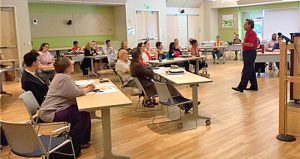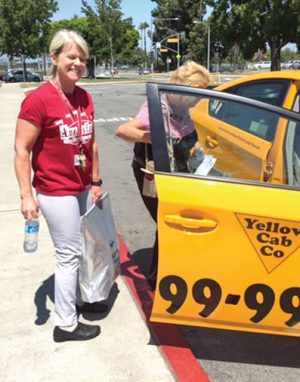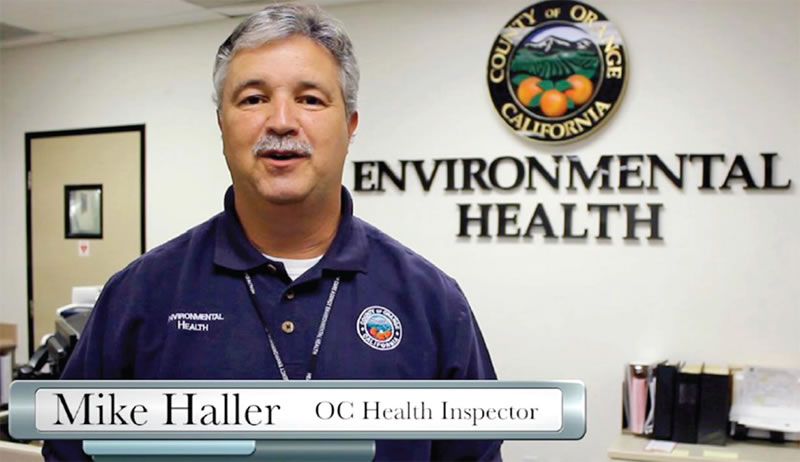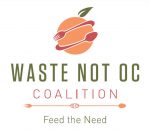The Waste Not Orange County Coalition is a public-private partnership that increases the flow of — and access to — wholesome nutrition for food-insecure families.
Nora Goldstein
BioCycle September 2016

“Social determinants of health are housing, employment and hunger,” says Dr. Eric Handler, shown (at right) addressing a workshop in New Haven, Connecticut. “If these determinants aren’t addressed, we will not be able to address health of our population in a sustainable manner.”
That conversation prompted a brainstorming of ideas to eliminate food insecurity in the county, which ultimately led to formation of Waste Not OC (Orange County) Coalition (WNOC) in November 2012. Handler and Lowry became the leaders of the WNOC Steering Committee. The Coalition is a public-private partnership formed with the goal of eliminating hunger and reducing food waste by facilitating donation of wholesome surplus food from food producing facilities to local pantries. WNOC partners with Food Finders, a 501c3 nonprofit organization that transports excess wholesome food from hospitals, restaurants and other businesses and institutions to food pantries in Orange County.
“The overall vision of WNOC is to end hunger in Orange County using a three pronged approach: Educating the community about food donations, identifying food insecure individuals and connecting those individuals to sources of food,” explains Handler. “Hunger is often perceived as a problem too big, too overwhelming for one community to handle. The solution to food insecurity lies in triaging responsibilities across programs in the county health department, private businesses, nonprofits, other organizations, and individuals.”
Since its founding, “305 TONS (500,013 meals) of newly recovered food have been given to those in need!,” announces a ticker on WNOC’s home page (www.wastenotoc.org). “Those metrics are the most important to us, which is why they are the first thing people see when visiting our website,” adds Handler.
Dr. Handler and Mike Haller, Orange County Environmental Health’s Food and Pool Safety Program Manager, were Keynote Speakers at BioCycle’s April 4, 2016 workshop, Wasted Food Prevention And Rescue, at BioCycle’s WEST COAST16 Conference in San Diego. After the Conference, we spoke with Handler and Haller about a range of topics — from “institutionalizing” food donation from food producers to connecting food insecure families to wholesome food at Orange County pantries.
Assessing The Need
BioCycle: How widespread is food insecurity in Orange County?
Handler: By our calculations, 335,000 Orange County residents — about 1 in 8 — face food insecurity on any given day. That includes 1 in 5 children. People are surprised by that statistic, given the wealth in some of our County’s communities. Feeding America provides statistics on food insecurity using its application, Map The Meal Gap. In 2013, 12.9 percent of the population in Orange County faced food insecurity. In 2014 the percentage dropped to 10.9 percent in part due to Waste Not OC.
But as the Orange County Public Health Officer, it’s important to share a broader perspective on this issue: Social determinants of health are housing, employment and hunger. If these determinants aren’t addressed, we will not be able to address health of our population in a sustainable manner. It is difficult because all three are such large issues that many people don’t know where to dip their toe in the ocean to address them. Having myself and others say we can make a difference with hunger is huge.
BioCycle: What tools does the County use to screen for food insecurity?
Handler: Prior to WNOC’s formation, doctors were reluctant to screen for food insecurity because they did not have the proper tools at hand to help their patients. Now, with WNOC’s food pantry Google Map, they are able to direct their patients to nearby pantries with ease.
We developed a set of Standard Practices for Clinics to address the relationship between food insecurity and health. Standard Practice #1 is to screen patients for food insecurity. This includes a 2-item screening tool with three possible answers — “often true,” “sometimes true,” or “never true” — used by health care professionals to quickly identify households with young children at risk for food insecurity, which enables providers to target services to ameliorate the health and developmental consequences associated with food insecurity.
The two prompts are:
• Within the past 12 months we worried whether our food would run out before we got money to buy more.
• Within the past 12 months the food we bought just didn’t last and we didn’t have money to get more.
If they screen positive — often or sometimes true — they may go through health assessments and will be connected with WNOC’s food pantry Google Map. Screening is now done at all 15 of the County’s Family Resource Centers, Children’s Hospital of Orange County (CHOC) as well as at other health care facilities servicing families. Over 40,000 people have been screened.
BioCycle: Is this screening unique to the Orange County health care system?
Handler: No, we see it being adopted in more cities and counties. In fact, this screening is so critical that in 2015-2016, Universal Screening for Hunger/Food Insecurity During Office Visits, was #7 on the American Academy of Pediatrics’ Top Priorities. It’s incredible that something so small as asking two questions is so huge in making a difference.
BioCycle: Has Orange County been able to get these screening tools institutionalized within the health care system in the county?
Handler: As a result of WNOC’s awareness campaign, AltaMed, a system of federally qualified community health centers and CHOC, have worked with WNOC to implement the food insecurity screening tool into their electronic health records and use WNOC’s interactive pantry map to provide food pantry information to those who struggle with hunger. And Orange County 211, an online, social services phone directory, has partnered with WNOC to combine pantry databases.
Food Donation
BioCycle: Is most of the food donated already prepared, or do the pantries also receive fresh produce?
Haller: Prepared foods can be donated. It is dependent upon the support structure of the recipients. For example, if a pantry does not have a refrigerator/freezer they will be limited on the types of foods they can accept, handle or store for extended periods of time. The key is matching the donor with the recipient.
The only foods that cannot be donated are expired baby food products including infant formula. For the most part, almost all packaged foods that may exceed their expiration code dates can be donated. Most people don’t realize this and discard perfectly safe food relying solely on a code date. Again, most of the code dates are arbitrary dates used by manufacturers to set quality limits on their products. These dates do not reflect safety measurements or criteria.
BioCycle: Waste Not OC targets food producers with excess wholesome food as its source of donations. What was the primary challenge in getting that started?
Handler: Shortly after forming WNOC, we brought together a group of about 30 people from the food industry, the county Board of Supervisors and our offices to discuss food donation. We asked restaurants why they are not donating food and they replied because the Orange County Environmental Health Department doesn’t allow it. Mike and I found that ironic because the California Retail Food Code explicitly states “any food facility may donate food to a food bank or to any other nonprofit charitable organization for distribution to persons free of charge.” And all entities donating food are protected from liability under the federal Good Samaritan Act.
Haller: Our challenge was how to bridge that education gap. Even though our office is under regulatory services, our primary role is education about the County’s food safety program, which includes letting food establishments know it is legal to donate food that they handle and store in a safe and sanitary manner, and they will not be liable for any damage that results from the consumption of the donated food. We have to walk a fine line between education and regulation, and didn’t want to come off as demanding they participate in donation.
BioCycle: What steps have you found most effective to bridge that gap?
Haller: What has been key is collaborating with food producers. Initially, WNOC targeted two cities — Anaheim and Orange. We worked with the food industry in those cities to create a Food Recovery Task Force, which is led by a restaurant owner and serves to bridge the gap between the health department and food producing facilities. Task Force members will follow up with businesses after a visit from a health inspector and are able to “speak the language” and connect valuable contacts in the industry to WNOC.
Even though we are not usually involved with addressing the topic of hunger, health inspectors have now become the first point of contact for promoting food donations and educating the business community on how to safely donate food without fear of liability.
BioCycle: Do the food producers derive a benefit as a result of participating in food donation?
Haller: Once we get food operators involved, they see how easy it is to participate. And they see a reduction in their trash pick-ups — and feel pride in being part of the program. It’s great when we get this feedback from a health inspector, but it is really critical when we hear it from the business managers and owners, who in turn, share this business model with other food producers.
Handler: We also anticipate that food producers required to comply with California’s AB 1826 will want to participate in food donation. AB 1826 was implemented statewide in April 2016. It mandates establishments generating over 8 cubic yards/week of organics, including food scraps, to arrange to have them recycled. Our partners such as Republic Services work with cities to encourage restaurants and grocery stores to focus primarily on food donations to comply with this requirement. Cities have expressed interest in utilizing WNOC to help meet this goal.
BioCycle: How does WNOC help ensure that healthy and wholesome food is being donated?
Handler: On our website, there is a list of healthy foods that can be donated. It’s part of the Tool Kit WNOC put together, which is available to other jurisdictions.
BioCycle: Is safety of donated foods addressed through the Environmental Health Department’s program?
Haller: One challenge we are encountering now is that while word has gotten out that these businesses are not liable if they donate food, they may still be resistant because of branding issues. They invest in food safety within their own operations, but as soon as the businesses release the food, it is up to recipients to ensure that it remains safe. We are developing a training module to deal with food safety called the FRESH program — Food Rescue Enhanced Safe Handling. What ServSafe* has done for the food industry and restaurants, FRESH will do for people transporting the food and the recipients.
*ServSafe, developed by the National Restaurant Association, is a food safety training and certification program for the food industry.

Food donated by Savanna High School in Anaheim (CA) is transported to a family resource center by a
Yellow Cab. Courtesy of Anaheim Union High School District
Logistics And Partnerships
BioCycle: Waste Not OC collaborates with Food Finders to deliver donated food to pantries. Has this nonprofit been able to keep up with demand for its services?
Haller: Food Finders has had to get more trucks and hire more staff. They definitely see the untapped resource of food out there to rescue. A practice that’s been adopted with both Food Finders and several of the food banks with refrigerated trucks is the importance of delivering perishable/prepared foods to pantries closest to the place where the food is picked up. Food Finders has worked out those logistics.
BioCycle: What about the late night pick-ups and delivery? Are those a challenge?
Handler: We do have a partnership with Yellow Cab Co. of Orange County to transport the donations, but don’t have to use the cab service very often. A significant benefit is that we are able to put the Waste Not OC seal in every cab, which helps to get the word out about the program. We are very excited about a pilot program implemented in August 2016. We are using Yellow Cab to pick up donated food from schools and delivering the food to the nearest pantry. Yellow Cab provided $750 to help fund the pilot.
Assessing The Impact
BioCycle: Have you been able to track how many families identified as food insecure actually utilize the food pantries?
Handler: This summer we’ve had three students from University of California Irving visit every food pantry in Orange County. They have been asking how many people they serve, what they are able to provide, if they can accept prepared foods and if they accept food after hours — which sometimes is when the prepared foods are available, e.g., after an event, and need to be delivered that evening. We will have preliminary data by the end of September.
BioCycle: What type of inroads has Waste Not OC made within Orange County government in terms of acceptance of this initiative? For example, is the positive impact recognized by elected officials in the county?
Handler: Yes, absolutely! In May, the Orange County Board of Supervisors adopted a recommendation to “Direct Orange County Health Care Agency to inform food facilities and operators within the County regarding the safe donation of excess food to food banks and nonprofit organizations; and Approve the distribution of a written brochure, ‘The Facts to Know When Donating Food’.” I’ve attended many Supervisor meetings and this is the first time I ever saw the Board of Supervisors applaud after discussion of an item and its passage.
And just last month, on August 23, the Board of Supervisors approved allocating $100,000 to WNOC to expand our operations. These funds will enable us to hire an Executive Director and a project manager, helping to grow what has been a shoestring operation.











